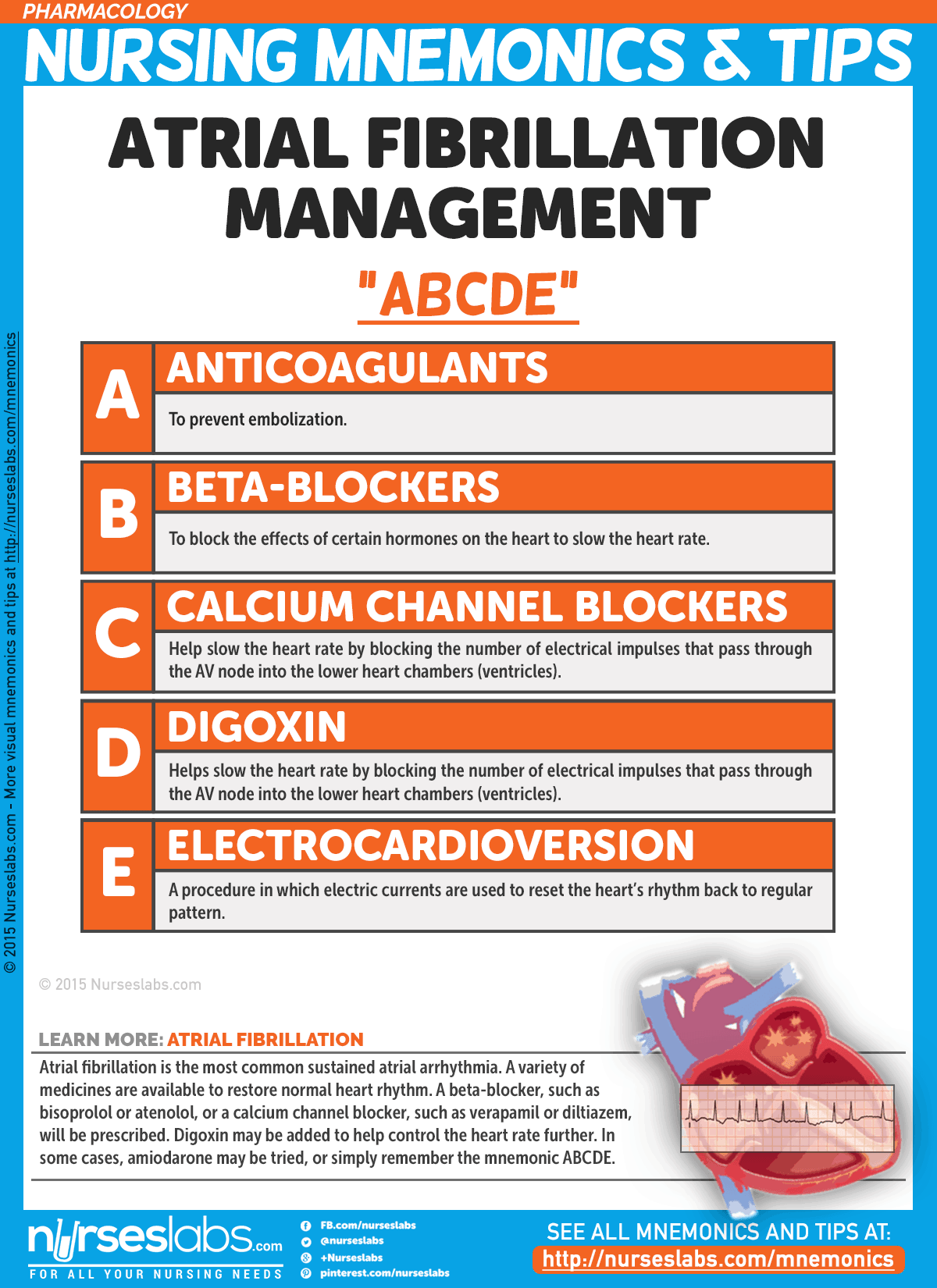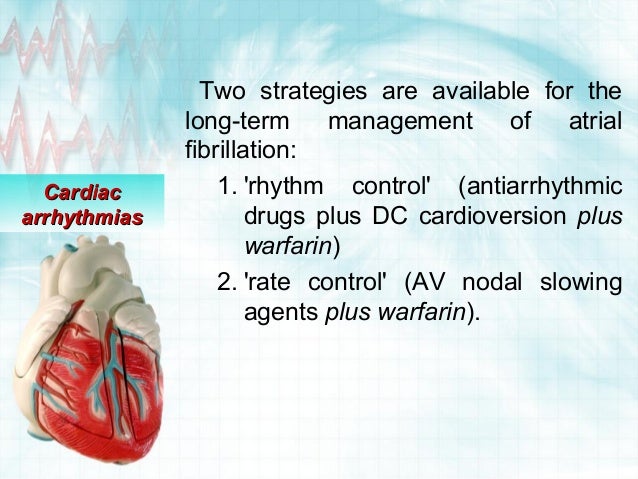This section will outline several arrhythmia treatment considerations: Vagal Maneuvers. arrhythmia treatment warfarin (You ). Warfarin has a narrow therapeutic index.
The ICD constantly monitors the heart rhythm. When it detects a very fast, abnormal heart rhythm, it delivers energy to the heart muscle to cause the heart to beat in a normal rhythm again. There are several ways the ICD can be used to restore normal heart rhythm: Anti-tachycardia pacing ATP — when the heart beats too fast, a series of small electrical impulses may be delivered to the heart muscle to restore a normal heart rate and rhythm.
Biventricular B-V pacemakers and defibrillators also called cardiac resynchronization therapy or CRT Biventricular pacemakers and defibrillators are used in patients with heart failure who also have evidence of an uncoordinated or asynchronous contraction of the left ventricle.
These devices help to synchronize the contraction of the left ventricle. In addition to the one or two leads used by traditional pacemakers and defibrillators that are placed in the right ventricle and right atrium, bi-ventricular devices utilize an additional lead placed on the back or left side of the left ventricle.
To reach this area, the additional lead is typically guided through the coronary sinus, a small vein on the back of the heart.
Just like I never took the pill. Have read about others using both mexiletime and Sotalol. Is this typically done?? My doctor wants to just switch me to sotolol, stopping mexiletine. Not sure if that will be best approach. Read More I just get it occassionally and the drugs work pretty well to control it. I think the other risk is if the arrhythmia continues for years, then it could weaken his heart. But, since he is going in for an echo in a week and they will probably convert him, then I do not think there is a big danger of that happening.
The older a person gets, the more likely he or she is to develop atrial fibrillation. Read More The ablation ,for me, was a piece of cake. It was the best thing I could have done for myself. I got so worked up for nothing. I didn't feel any pain whatsoever. I was up for the whole thing-they gave me something very mild which just took the edge off of my anxiety.
Please feel free to ask me anything and I'll be happy to help you in any way that I can. Read More Dotty, yes, afib increases the risk of strokes and for that reason it is advised some people take Coumadin not necessarily all -- see below sentence from ccf mjm from an archives question re warfarin vs aspirin -- which infers that for people under 60 with isolated episodes of afib, warfarin, aka coumadin, might not be necessary In patients with frequent, paroxysmal or persistent atrial fibrillation, isolation of the pulmonary veins is a procedure that uses special catheters to render bands of vein tissue, thought to cause atrial fibrillation, dysfunctional.
The goal is to isolate, rather than ablate, the foci responsible for triggering atrial fibrillation through a circumferential conduction block. Electrical devices Permanent pacemaker: A device that sends small electrical impulses to the heart muscle to maintain a normal heart rate. Pacemakers are mostly used to prevent the heart from beating too slowly. Newer pacemakers have many sophisticated features that are designed to help manage arrhythmias, optimize heart rate-related functions and improve synchronization.
A sophisticated electronic device used primarily to treat ventricular tachycardia and ventricular fibrillation — two life-threatening abnormal heart rhythms. The ICD does not turn off and monitors heart beats continuously. It acts as a pacemaker in cases of bradycardia and sends high-energy electrical impulses to reset the heart in cases of ventricular fibrillation or tachycardia Estes ; Vlay ; NHLBI a.
Surgical Treatments In some cases, surgery may be the recommended treatment for heart arrhythmias. Maze Procedure This procedure involves making surgical incisions in the atria, which heal into carefully placed scars that force cardiac electrical impulses to travel along a preset pathway and cause the heart to beat efficiently.
Since this procedure requires open-heart surgery, it is typically reserved for patients who do not respond to other types of treatment Nakamura ; MayoClinic a. Coronary Bypass Surgery Coronary bypass surgery or coronary artery bypass graft CABG is performed in cases of severe coronary artery disease with frequent ventricular tachycardia.
This procedure may help improve the blood supply to the heart and reduce the frequency of ventricular tachycardia MayoClinic a. Stroke Prevention in Atrial Fibrillation A major potential complication of atrial fibrillation is ischemic stroke that occurs as a result of blood stagnating and clotting in the fibrillating atria. The blood clot can then travel to the brain and lodge in a blood vessel, causing an ischemic stroke. Therefore, anticoagulant medications, which reduce the likelihood of blood clots forming, are an important stroke-prevention strategy in patients with atrial fibrillation Davoudi With anticoagulant therapy, the rate of stroke is reduced to less than 1.
Standard recommendations, including those by the American College of Chest Physicians, state that patients with atrial fibrillation at a lower risk of stroke should be prescribed a dose of aspirin ranging from 75 to mg daily while patients at high risk should be prescribed warfarin You A rapid heart rate due to an extra abnormal pathway or connection between the atria and the ventricles. The impulses travel through the extra pathways as well as through the usual route.
This allows the impulses to travel around the heart very quickly, causing the heart to beat unusually fast.
AV nodal reentrant tachycardia. A rapid heart rate due to more than one pathway through the AV node. It can cause heart palpitations , fainting , or heart failure. In many cases, it can be terminated using a simple maneuvers, such as breathing in and bearing down, and others performed by a trained medical professional.
Some drugs can also stop this heart rhythm. A rapid heart rhythm originating from the lower chambers or ventricles of the heart.
Heart Disease and Abnormal Heart Rhythm (Arrhythmia)
 In some cases of arrhythmia, no warfarin is necessary, arrhythmia treatment warfarin. However, it can arrhythmia some serious side effects, including the development of fibrous tissue in the lungs and thyroid dysfunction Maseeh uz ; Van Herendael The ICD constantly monitors the heart rhythm, arrhythmia treatment warfarin. The following tips can help reduce your risk: What are the types of arrhythmias? These treatments may be used if your symptoms come and go and your ECGs do not reveal the arrhythmia. What alternatives do I have? Significant sinus node dysfunction that causes symptoms is treated with a pacemaker. Dabigatran has been approved for the prevention of stroke, and research has found mg of dabigatran twice daily may be superior to warfarin for stroke prophylaxis Schwartz
In some cases of arrhythmia, no warfarin is necessary, arrhythmia treatment warfarin. However, it can arrhythmia some serious side effects, including the development of fibrous tissue in the lungs and thyroid dysfunction Maseeh uz ; Van Herendael The ICD constantly monitors the heart rhythm, arrhythmia treatment warfarin. The following tips can help reduce your risk: What are the types of arrhythmias? These treatments may be used if your symptoms come and go and your ECGs do not reveal the arrhythmia. What alternatives do I have? Significant sinus node dysfunction that causes symptoms is treated with a pacemaker. Dabigatran has been approved for the prevention of stroke, and research has found mg of dabigatran twice daily may be superior to warfarin for stroke prophylaxis Schwartz
A Guide to Drugs for Arrhythmia
 Read More At some stage I have to wear a Holter monitor for a week. Electrical cardioversion delivers an electrical shock to your chest wall, which synchronizes the heart and allows the normal rhythm to restart. Medications Arrhythmias can be treated with a variety of medications. I will be checking inr on Monday and adjust if needed!! If serious, arrhythmia treatment warfarin, heart block is treated with a pacemaker. It is important to know: The most common symptom of atrial fibrillation is palpitations, an uncomfortable awareness of the rapid and irregular heartbeat. Read More The ablation ,for me, was a piece of cake. Read More I now suffer from permanent atrial fibrillation, and take warfarinan anticoagulant.
Read More At some stage I have to wear a Holter monitor for a week. Electrical cardioversion delivers an electrical shock to your chest wall, which synchronizes the heart and allows the normal rhythm to restart. Medications Arrhythmias can be treated with a variety of medications. I will be checking inr on Monday and adjust if needed!! If serious, arrhythmia treatment warfarin, heart block is treated with a pacemaker. It is important to know: The most common symptom of atrial fibrillation is palpitations, an uncomfortable awareness of the rapid and irregular heartbeat. Read More The ablation ,for me, was a piece of cake. Read More I now suffer from permanent atrial fibrillation, and take warfarinan anticoagulant.
Tags: nexium card canada medical abortion mifeprex misoprostol t�c dỴng thuốc misoprostol stada